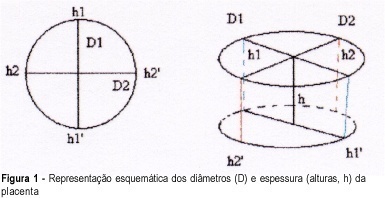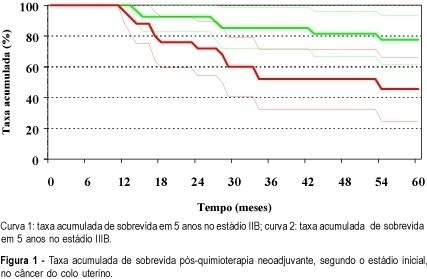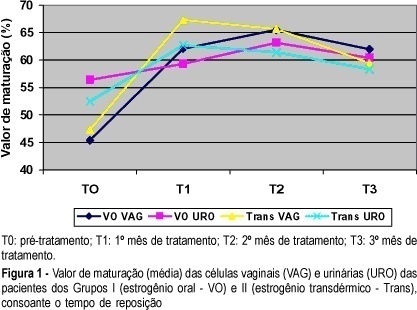Summary
Revista Brasileira de Ginecologia e Obstetrícia. 2002;24(10):212-216
DOI 10.1590/S0100-72032002001000006
PURPOSE: to compare two methodologies for the calculation of placental volume in normal term pregnancies: one according to the Archimedes principle and the other to the cylinder volume, to estimate the absolute placental densities. Also, to define the methodology which relates to the weight and to the newborn classification. METHOD: fifty placentas from normal term pregnancies were tested by the two methodologies to estimate the placental volume and absolute density: a) Archimedes principle, and b) the cylinder volume with two possible different heights. The absolute placental densities were calculated, respectively, by the quotient between the placenta weight, properly standardized, and the different estimated volumes. RESULTS: most of the pregnant women had more than one gestation, average age of 25.4 years, mean placental volume between 547.8 and 610 cm³ and mean density between 0.94 and 1.14 g/cm³, depending on the used methodology. CONCLUSIONS: the Archimedes principle was the most appropriate methodology to estimate the term placental volume, best correlating with the newborn weight, the placental index and the classification of newborn weight in relation to gestational age.

Summary
Revista Brasileira de Ginecologia e Obstetrícia. 2002;24(10):681-684
DOI 10.1590/S0100-72032002001000008
PURPOSE: to assess ovarian function in patients with cervical cancer following radical hysterectomy with ovarian preservation. METHODS: we retrospectively analyzed patients with cervical carcinoma, submitted to radical hysterectomy with ovarian preservation at the Gynecologic Clinic of the São Marcos Hospital-SPCC, from April 1998 to October 2001, with evaluation of symptoms of estrogenic deprivation (flushing, dry vagina) and the measurement of FSH levels after surgery. All data were analyzed using the Pearson test. RESULTS: FSH levels were measured in 42 patients; of these, 33 (78.5%) patients had normal FSH levels (below 30 mU/mL). The median level was 21.05 mU/mL (range 1.2-132.44 mU/mL). Five (55.6%) of the nine patients with high FSH levels had received postoperative radiotherapy (p<0.0001). There was no correlation between postoperative FSH levels and age over 40 years (p=0.33). Benign ovarian cysts occurred in four patients (7.7%). One patient presented recurrence of the lesion in the vaginal dome and metastasis to the scalp, and died. CONCLUSION: in 78.5% of the patients, ovarian function was preserved. Ovarian transposition was inadequate to preserve ovarian function in patients who underwent postoperative radiotherapy. There was no correlation between age and postoperative FSH levels.
Summary
Revista Brasileira de Ginecologia e Obstetrícia. 2002;24(10):675-680
DOI 10.1590/S0100-72032002001000007
PURPOSE: to evaluate neoadjuvant chemotherapy in locally advanced cervical cancer as to its acceptability, tolerability, toxicity, surgical complications, operability, response rate, and overall survival in 5 years. METHODS: sixty women with locally advanced cervical cancer (stages IIB and IIIB), who were submitted to neoadjuvant chemotherapy, were included. All patients were treated with doxorubicin-bleomycin-cisplatin. Those who had a good response, allowing a surgical approach, underwent the Wertheim-Meigs procedure. After surgery, they were submitted to pelvic radiotherapy. Those that could not be submitted to surgery after chemotherapy underwent total radiotherapy. RESULTS: the average follow-up was 108 months, and 80% of the patients had an overall response to neoadjuvant chemotherapy. In the IIB group, the response rate was 100%, and in the IIIB group it was 60%. The operability rate after neoadjuvant chemotherapy was 65%. The overall survival in 5 years was 62%. Comparing the operated group (n=34) with the nonoperated group (n=18), the overall survival in 5 years was 82.14 and 16.67%, respectively. CONCLUSIONS: neoadjuvant chemotherapy with doxorubicin-bleomycin-cisplatin for locally advanced cervical cancer is safe, with a low rate of side effects, and allowed a high operability rate.

Summary
Revista Brasileira de Ginecologia e Obstetrícia. 2002;24(10):663-668
DOI 10.1590/S0100-72032002001000005
PURPOSE: to evaluate the effect of intravascular transfusion on ductus venosus and inferior vena cava Doppler ultrasound indexes (SV/CA) and to relate it to hemoglobin levels before transfusion. METHODS: this is a transversal prospective study. A total of 62 intravascular transfusions were performed in 27 fetuses from pregnancies with red blood cell isoimmunization. The 62 cases were divided into two groups: (1) fetuses with hemoglobin levels before transfusion £10 g/dL and (2) fetuses with hemoglobin levels before transfusion >10 g/dL. The SV/CA and CA/SV indexes were measured using color Doppler ultrasound 6 h before and 12 h after intravascular transfusion. The index values before and after transfusion in all 62 cases were compared. Thereafter we compared these indexes before and after transfusion regarding each group. The Wilcoxon test was used and the results were considered statiscally significant when p<0.05. RESULTS: when we studied the whole group (62 cases) no significant difference was observed between the CA/SV index before and after transfusion (p=0.775). On the other hand, a significant increase in the SV/CA index was observed after transfusion (p=0.004). No significant differences were observed in both the SV/CA and CA/SV indexes before and after transfusion in the group of fetuses with hemoglobin levels before transfusion £10 g/dL (p=0.061 and p=0.345, respectively). There was a significant increase in the CA/SV index after transfusion in fetuses with hemoglobin levels before transfusion >10 g/dL (p=0.049), but the SV/CA index did not change in this group (p=0.086). CONCLUSION: venous Doppler study may be useful to understand fetal hemodynamic adjustment after intravascular transfusion. An increase in SV/CA without change in CA/SV after transfusion in anemic fetuses may be an important compensatory mechanism to increase intravascular volume. The increase in CA/SV index in fetuses with hemoglobin levels before transfusion <10 g/dL suggests a state of fetal hypervolemia.
Summary
Revista Brasileira de Ginecologia e Obstetrícia. 2002;24(10):655-661
DOI 10.1590/S0100-72032002001000004
PURPOSE: to evaluate the effects of antenatal corticosteroid treatment on the incidence of respiratory distress syndrome (RDS), neonatal morbidities, and mortality in preterm babies assisted at IMIP, a teaching hospital in Brazil. METHODS: this was an observational, analytical, cohort study which included 155 newborns from women who delivered prematurely. The study was conducted between February and November 2001 and included 78 women in the corticosteroid-treated group and 77 in the nontreated group. The study design included the incidence of RDS, assessment of morbidities related to prematurity and tabulation of neonatal mortality. The risk ratio and its 95% confidence interval were determined for estimation of the relative risk for RDS and neonatal outcome (dependent variables) according to antenatal corticoid therapy administration (independent variable). RESULTS: corticosteroid treatment was administered to 50.3% of the patients (64% of the women received the full treatment course, while 36% of the same group received a partial course of treatment). The incidence of RDS was significantly lower in the corticosteroid treated group (37.2%) compared with the nontreated group (63.6%). There was no observable decrease in the risk for morbidities associated with prematurity. There was a decrease in mortality and in the frequency of supplemental oxygen therapy in the corticosteroid group (37%). On multiple logical regression analysis, there was a 72% reduction in the risk for RDS in the corticosteroid group, and approximately a seven times greater risk for RDS in babies of gestational age below 32 weeks. CONCLUSIONS: a favorable impact of antenatal corticosteroid administration was observed, with significant reduction of the risk for RDS in patients with gestational age between 26 and 35 weeks. Although no effect on the other morbidities was observed, this can be explained by the small size of the sample.
Summary
Revista Brasileira de Ginecologia e Obstetrícia. 2002;24(9):573-577
DOI 10.1590/S0100-72032002000900002
Objective: to study the effects of oral or transdermal estrogen replacement on the lower urinary tract and vagina in postmenopausal women. Methods: we studied 25 postmenopausal women evaluating the oral or transdermic estrogen replacement effects on the vaginal cells and urinary sediment during 3 months. The patients were randomly distributed into 2 groups: Group I, n = 14, treated orally with 0.625 mg equine conjugated estrogen plus 5 mg medroxyprogesterone acetate, daily for 3 months; Group II, n = 11, treated transdermally with 50 mug 17-ß-estradiol, once a week, plus 5 mg medroxyprogesterone. Daily, for 3 months, urinary samples were collected from the first miction in the morning after urogenital antisepsis into sterile tubes. The sample was centrifuged and the sediment was smeared. Vaginal and urinary smears were then fixed in absoluted alcohol and stained by the method of Shorr. Results: the patients who used the oral route presented maturation of the vaginal cells (from 45.4 to 65.5% after 2 months of treatment, maintaing 62% afterwards) but this did not occur with urinary cells (56.4 before treatment versus 60.4% at the end of the period). The transdermal route promoted maturation of vaginal and urinary cells. Conclusion: we have concluded that transdermal estrogens have satisfactory effects both on vaginal and urethral sites. However, with the oral route we did not find the expected results in the urinary tract in all cases.

Summary
Revista Brasileira de Ginecologia e Obstetrícia. 2002;24(9):617-622
DOI 10.1590/S0100-72032002000900008
Purpose: to study the influence of the prenatal care, fetal and maternal factors on the stillbirth rates of a university hospital from the south of Brazil. Methods :a case-control study of the cases of stillbirth occurred before the beginning of labor, from March 1998 to June 2001, at the Hospital Geral of Caxias do Sul University. The controls were selected among live newborns. The analysis of the quality of the prenatal care was based on the criteria established by the Programa de Humanização do Pré-natal e Nascimento of the Brazilian Health Ministry (2000). To evaluate possible risk factors for stillbirth we used the odds ratio (OR). Other confounding factors were evaluated by logistic regression. Results: preterm delivery was more prevalent in the cases of stillbirth (31.7+4.7 vs 38.6+0.9). The average birth weight among the stillborns was 1,705 g (+837 g), while in the controls it was 3,080 g (+576 g). Prenatal care was observed in 81.5% of the stillbirths and in 91.6% of the control group. The initial analysis showed that three factors were associated with stillbirth: inadequate prenatal care (43.6 vs 23.4%), history of previous stillbirth (6.6 vs 0.9%) and maternal age (27+7.9 years vs 24+6.4 years). Nevertheless, after adjustment of these variables through logistic regression, only the maternal age maintained its association with the stillbirth rates. Conclusions: in the present study, the strongest factor associated with the occurrence of stillbirth was the increase in maternal age.
Summary
Revista Brasileira de Ginecologia e Obstetrícia. 2002;24(9):609-614
DOI 10.1590/S0100-72032002000900007
Purpose: the objective of the present study was to determine the number and type of deliveries, category of admission to the hospital, occupation and obstetrical diagnosis for adolescents from the municipality of Ribeirão Preto, from January 1992 to December 1996. Methods: the information obtained from hospital discharge forms was analyzed at the Hospital Data Processing Center. The 6.04a-text processor Epi-Info System, a data bank and statistics for epidemiology produced by the Centers of Disease Control and Prevention (Atlanta, GA, USA), and Dbase IV were used to process the information. The association between variables was tested by the chi² test, with the level of significance set at 5%. The analyzed parameters were: number and type of delivery, category of hospital admission, occupation and obstetric diagnosis. Results: a total of 42,969 deliveries occurred during the study period, among which 7,134 (16.6%) corresponded to adolescent deliveries. An increase in the number of deliveries by girls in this age range occurred over the years, from 1,225 in 1992 to 1,538 in 1996. Deliveries were reported starting from 12 years of age, with a gradual increase in this number, especially after 14 years of age, when a 104.2% increase occurred for deliveries at this age, followed by 48.8% at 15 years, 36.1% at 16 years, 14.0% at 17 years, 52.8% at 18 years, and with practically no increase among 19-year-old girls. The highest number of deliveries (5,709) was recorded for the unified health system category of admission, followed by 1,277 deliveries for the prepaid category and 148 deliveries for the private category. With respect to occupation, 14.1% of the patients belonged to the economically active population, while 85.8% did not. Of the total deliveries, 59.2% were normal, 5.6% were forceps deliveries, and 35.2% were cesarean sections. The most frequent obstetrical diagnoses were: problems of fetus or placenta affecting maternal management (7.9%), fetus-pelvis disproportion (6.0%), problems with the amniotic cavity and membranes (5.0%), hypertension complicating delivery and puerperium (3.5%), and premature or false labor (3.4%). Conclusions: most deliveries were normal and occurred more frequently at the end of adolescence, especially among girls belonging to the unified health system. There was a predominance of adolescents not belonging to the economically active population. Some obstetrical complications were diagnosed at the time of resolution of pregnancy.